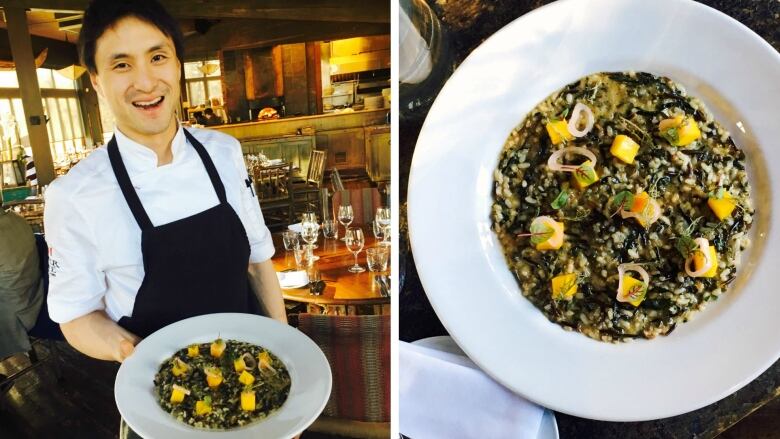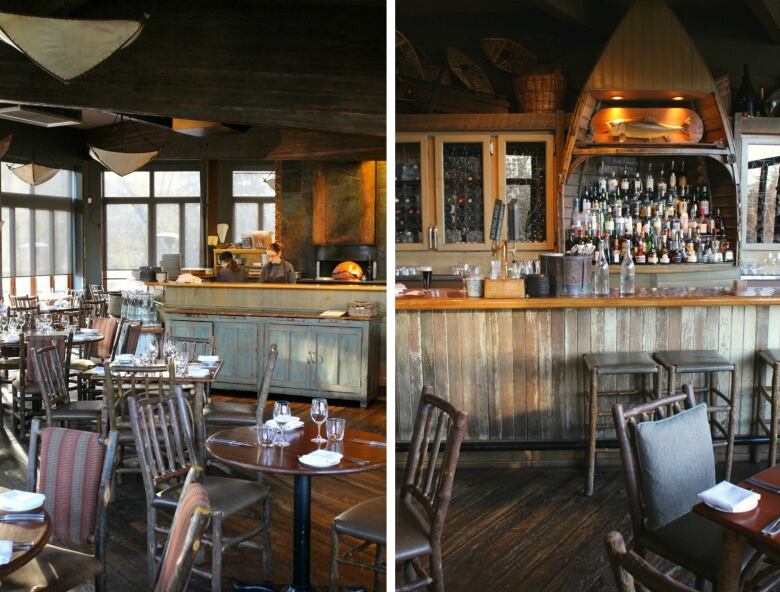River Caf's Matthias Fong brings a world of techniques to the Canadian table
'I was raised on dumplings and bologna sandwiches on white bread'

It was a love of cooking and of absorbing as much as he could through cookbookswhile studying sociology at the University of Calgarythat drew executive chef Matthias Fong into the kitchen at River Caf.
"People always ask, 'What style of cooking do you do?' And I couldn't really tell you.I don't have formal French training. All I've learned has been on the joband cooking with my mom," Fong said.
"And reading, buying as many books as I can get my hands on, doing my own research, learning the science behind why things work and why food matters."
Fong was born in Calgary and grew up in the northwest community ofEdgemont.
- FOOD AND THE CITY | Cassis Bistro chef trades techniques with Mama Rgine in South of France
- FOOD AND THE CITY |Metrovino's Richard Harvey: Evangelical about Sherry
He would sit on the kitchen counter as his mom and grandma, who emigrated from Hong Kong, steamed dumplings and braised chicken feet.
"I spoke Cantonese at home, English with my friends, and French at school," said the former French immersion student.
"I was raised on dumplings and bologna sandwiches on white bread."
Eventually Fong started cooking on his own for charity events and a local youth group, and he discovered he loved it.

Getting a kitchen job
The summer after graduating from high school, Fong visited RiverCaf.
"I walked in the door and said, 'Please, give me a job,'" he explained. "I knew this was a good restaurant, and the philosophy behind it."
Almost a decade later, Fong is a year into his stint as executive chefat the iconic caf on Prince's Island Park, which is celebrating 25 years in business this year.
He worked alongside past chefs Scott Pohorelic and Andrew Winfield, both now instructors at the SAIT culinary arts program.
He did a stint in London, working with British Michelin-starred chef Marcus Wareing before deciding to return to River Caf.

Food philosophy
Although "local and seasonal" has become de rigueur in most restaurant claims these days, River Caf have been pioneers in this regard.
Founder and owner Sal Howell is a passionate advocate for cooking with and eating local, seasonal and sustainable ingredients, and she's fostered this philosophy at River Caf since its inception.
Fong and his team are now working to replace ingredients that are staples in most restaurant kitchens olive oil, lemon juice, even the soy sauce he grew up with with locally sourced alternatives.
Highwood Crossing and Mountainview cold-pressed canola oils, both made from Canadian non-GMO canola seed, and Three Farmers Camelina oil are their primary cooking oils, as well as Highwood Crossing flax oil and some sunflower oil.

They've been malting and fermenting Red Fife wheat in order to make a tangy, unique sauce similar to soy, turning the runoff from their local Wild Rose brown ale tap into vinegar.
They even made a jug out of Big Rock's seasonal Bourbon Porter and they're using sumac to recreate the tang of a squeeze of lemon juice.
"The ingredient is the main thing. If the ingredient is local and sustainable, good for the future of food, it'll really show through in the finished dish. When people eat here, I hope people will see that that the food is delicious, but it's also a bit different," Fong said.
When a specific ingredient, like asparagus or carrots, is at its peak, it's incorporated as much as possible on the menu.
They draw from the gardens that surround them on Prince's Island, and from year-round greenhouses that provide ingredients like Swiss chard and microgreens.
Other produce is frozen or preserved to last the winter and spring.They even roast and put up their own tomatoes.

A multicultural, Canadian cuisine
"It's a huge amount of work," Fong said.
"It requires a lot of time and effort, but fortunately Sal Howell has always been very supportive. It's not just local for the sake of local, but local for the sake of developing that flavour profile, of being aware of what's around us," he said.
"I feel like I'm also educating myself," he says, when asked about the role River Caf plays in defining Canadian cuisine. Other countries have very defined cuisines, but ours is less so. I think it has a lot to do with the diversity of Canadian cultures and cooking styles. Fortunately, I'm that mixture," Fong said.
"I'm a Canadian kid.I draw from different cultures, different experiences and techniques and apply them to locally grown food to create food that has its flavour profile, instead of copying the flavour profile of another cuisine."
Blending tradition with creativity
Fong's Canadian rice porridge is made with wild rice, a commonly known Canadian ingredient, but also brown and white rice.
This particular riceissourced from an artisan sake maker on Granville Island, who grows rice in Abbotsford the most northerly commercial rice production in the world.
"We replaced the rice in our rice puddingand in the risotto, but when it's not made with Arborio rice, it's not really risotto either," Fong said.
"Risotto is Italian.It's cheesy.It has its own style. It doesn't have the same texture as ours, made with Canadian ingredients," he explained.
"I grew up on congee, but [this is]not really congee either. So we called it porridge, which sounds more intriguing," he said.

Using a combination of techniques, a pinch of Kootenay alpine grana (a hard cheese modelled after an Italian Piave) and even crispy Reindeer lichen, which grows in the same areas chanterelle mushrooms are foraged, the result is spectacular, similar to risotto but uniquely Canadian.
"It doesn't have as much of a reference point for people to look at and say, 'That's risotto,' and compare it to other dishes they've had," he said.
- FOOD AND THE CITY |Oak Room barman Patrick Appave on 35 years at the Palliser
- FOOD AND THE CITY |Chefs help tell the Making Treaty 7 story through Indigenous cuisine
"I'm still having a hard time defining what I'm doing, but that's exciting, the fact that I can't put a name on it," Fong said.
"I realized that the food I wanted to make didn't have a context to it."
Taste over technique
Fong's repertoire of techniques is a mixed bunch gleaned from hislife experiences.
"Techniques from Hong Kong, where my grandparents would cook," he offered as an example.
"I would take them for granted, but now I realize they work. I want to apply whatever technique works, no matter what it's from, using the ingredients from around here," he said.
"Sometimes the guys in the kitchen watch me and say, 'If that was a French technique, you would have botched it,' but it's all perspective.
"I ask them, does it taste good? Does it work? If the answer is 'Yes,' if the end result is what you want, I don't worry so much about whether it was a proper technique to get there.
"At the end of the day, people want food to taste good."












_(720p).jpg)


 OFFICIAL HD MUSIC VIDEO.jpg)
.jpg)



























































































